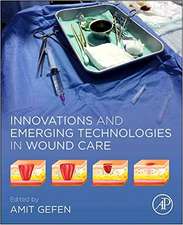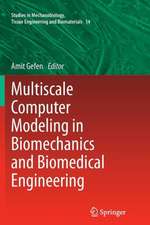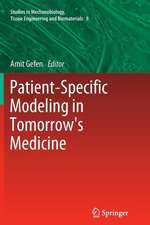The Science, Etiology and Mechanobiology of Diabetes and its Complications
Editat de Amit Gefenen Limba Engleză Paperback – 26 apr 2021
Biologists, life scientists, physicians, pharmacists, biomedical engineers, medical physicists, biomathematicians and computer scientists who are interested in the state-of-science and current challenges in the mechanobiology of diabetes should find this book very useful. Likewise, medical researchers in fields such as endocrinology, cardiovascular medicine, oncology, obesity, the immune system, inflammation and wound care and others who wish to be updated about the latest achievements in this exciting arena of research will find that information here.
- Covers the state-of-knowledge in diabetes research from a mechanobiological perspective, including cell death and (neural, connective, adipose, vascular, renal etc.) tissue damage cascades and healing processes
- Describes state-of-the-art technology in prevention, diagnosis, prognosis and treatment of tissue, organ and body system damage caused by chronic hyperglycemia and diabetes
- Explores emerging research directions and future technology trends in the field of diabetes prevention and care, including common complications of diabetes (foot ulcers and amputation, peripheral neuropathy, retinal damage, renal damage, vascular and cardiac damage, connective tissue damage etc.) at the early stage of research and development in academia and industry
Preț: 915.32 lei
Preț vechi: 1182.32 lei
-23% Nou
Puncte Express: 1373
Preț estimativ în valută:
175.16€ • 181.84$ • 146.06£
175.16€ • 181.84$ • 146.06£
Carte tipărită la comandă
Livrare economică 18 martie-01 aprilie
Preluare comenzi: 021 569.72.76
Specificații
ISBN-13: 9780128210703
ISBN-10: 0128210702
Pagini: 434
Ilustrații: Approx. 150 illustrations (150 in full color)
Dimensiuni: 191 x 235 mm
Greutate: 0.74 kg
Editura: ELSEVIER SCIENCE
ISBN-10: 0128210702
Pagini: 434
Ilustrații: Approx. 150 illustrations (150 in full color)
Dimensiuni: 191 x 235 mm
Greutate: 0.74 kg
Editura: ELSEVIER SCIENCE
Cuprins
1. Heel ulcers in patients with diabetes
Michael Clark
2. Diabetic foot ulcers and their wound Management
Norihiko Ohura, Katsuya Hisamichi
3. Computational modeling of the plantar tissue stresses induced by the clinical practice of off-loading of the diabetic foot
Hadar Shaulian, Amit Gefen, Alon Wolf
4. Modeling effects of sustained bodyweight forces on adipose tissue microstructures and adipocytes in diabesity
Maayan Lustig, Golan Amrani, Adi Lustig, Liran Azaria, Raz Margi, Yoni Koren, Avraham Kolel, Nurit Bar-Shai, Avior Exsol, Maya Atias, Amit Gefen
5. Mechanisms underlying vascular stiffening in obesity, insulin resistance, and type 2 diabetes
Michael A. Hill, Yan Yang, Zhe Sun, Liping Zhang, James R. Sowers
6. Pathomechanics of diabetic foot ulceration: revisiting plantar shear and temperature
Metin Yavuz
7. Novel technologies for detection and prevention of diabetic foot ulcers
Neil D. Reeves, Bill Cassidy, Caroline A. Abbott, Moi Hoon Yap
8. The role of tissue biomechanics in improving the clinical management of diabetic foot ulcers
Panagiotis Chatzistergos, Roozbeh Naemi, Nachiappan Chockalingam
9. The mechanobiology of adipocytes in the context of diabetes: much more than a fat depot
Shirley L. Yitzhak-David, Daphne Weihs
10. Optical Coherence Tomography to determine and visualize pathological skin structure changes caused by diabetes
Raman Maiti, Roger Lewis, Daniel Parker, Matt J. Carré
11. Effects of hyperglycemia and mechanical stimulations on differentiation fate of mesenchymal stem cells
Tasneem Bouzid, Jung Yul Lim
12. Clinical complications of tendon tissue mechanics due to collagen crosslinking in diabetes
Jennifer A. Zellers, Jeremy D. Eekhoff, Simon Y. Tang, Mary K. Hastings, Spencer P. Lake
13. A phenomenological dashpot model for morphoelasticity for the contraction of scars
F.j. Vermolen
14. Mechanobiology of diabetes and its complications: from mechanisms to effective mechanotherapies
Chenyu Huang, Rei Ogawa
15. Application of tissue mechanics to clinical management of risk in the diabetic foot
Daniel Parker, Farina Hashmi
16. Bone carriers in diabetic foot osteomyelitis
Cristian Nicoletti
17. Vascular mechanobiology and metabolism
Sarah Basehore, Jonathan Garcia, Alisa Morss Clyne
18. Effect of type 2 diabetes on bone cell behavior
Rachana Vaidya, Anna Church, Lamya Karim
19. What makes a good device for the diabetic foot
Evan Call, Darren F. Groberg, Nick Santamaria
20. Allostasis: a conceptual framework to better understand and prevent diabetic foot ulcers
Laurel Tanner, Craig Oberg, Evan Call
21. Footwear for persons with diabetes at high risk for foot ulceration: offloading, effectiveness, and costs
Sicco A. Bus
22. Compounding effects of diabetes in vessel formation in microvessel fragmentebased engineered constructs
Omar Mourad, Blessing Nkennor, Sara S. Nunes
23. Dressing selection challenges in diabetic foot local treatment
Paulo Alves, Tania Manuel, Nuno Mendes, Emília Ribeiro, Anabela Moura
Michael Clark
2. Diabetic foot ulcers and their wound Management
Norihiko Ohura, Katsuya Hisamichi
3. Computational modeling of the plantar tissue stresses induced by the clinical practice of off-loading of the diabetic foot
Hadar Shaulian, Amit Gefen, Alon Wolf
4. Modeling effects of sustained bodyweight forces on adipose tissue microstructures and adipocytes in diabesity
Maayan Lustig, Golan Amrani, Adi Lustig, Liran Azaria, Raz Margi, Yoni Koren, Avraham Kolel, Nurit Bar-Shai, Avior Exsol, Maya Atias, Amit Gefen
5. Mechanisms underlying vascular stiffening in obesity, insulin resistance, and type 2 diabetes
Michael A. Hill, Yan Yang, Zhe Sun, Liping Zhang, James R. Sowers
6. Pathomechanics of diabetic foot ulceration: revisiting plantar shear and temperature
Metin Yavuz
7. Novel technologies for detection and prevention of diabetic foot ulcers
Neil D. Reeves, Bill Cassidy, Caroline A. Abbott, Moi Hoon Yap
8. The role of tissue biomechanics in improving the clinical management of diabetic foot ulcers
Panagiotis Chatzistergos, Roozbeh Naemi, Nachiappan Chockalingam
9. The mechanobiology of adipocytes in the context of diabetes: much more than a fat depot
Shirley L. Yitzhak-David, Daphne Weihs
10. Optical Coherence Tomography to determine and visualize pathological skin structure changes caused by diabetes
Raman Maiti, Roger Lewis, Daniel Parker, Matt J. Carré
11. Effects of hyperglycemia and mechanical stimulations on differentiation fate of mesenchymal stem cells
Tasneem Bouzid, Jung Yul Lim
12. Clinical complications of tendon tissue mechanics due to collagen crosslinking in diabetes
Jennifer A. Zellers, Jeremy D. Eekhoff, Simon Y. Tang, Mary K. Hastings, Spencer P. Lake
13. A phenomenological dashpot model for morphoelasticity for the contraction of scars
F.j. Vermolen
14. Mechanobiology of diabetes and its complications: from mechanisms to effective mechanotherapies
Chenyu Huang, Rei Ogawa
15. Application of tissue mechanics to clinical management of risk in the diabetic foot
Daniel Parker, Farina Hashmi
16. Bone carriers in diabetic foot osteomyelitis
Cristian Nicoletti
17. Vascular mechanobiology and metabolism
Sarah Basehore, Jonathan Garcia, Alisa Morss Clyne
18. Effect of type 2 diabetes on bone cell behavior
Rachana Vaidya, Anna Church, Lamya Karim
19. What makes a good device for the diabetic foot
Evan Call, Darren F. Groberg, Nick Santamaria
20. Allostasis: a conceptual framework to better understand and prevent diabetic foot ulcers
Laurel Tanner, Craig Oberg, Evan Call
21. Footwear for persons with diabetes at high risk for foot ulceration: offloading, effectiveness, and costs
Sicco A. Bus
22. Compounding effects of diabetes in vessel formation in microvessel fragmentebased engineered constructs
Omar Mourad, Blessing Nkennor, Sara S. Nunes
23. Dressing selection challenges in diabetic foot local treatment
Paulo Alves, Tania Manuel, Nuno Mendes, Emília Ribeiro, Anabela Moura



























